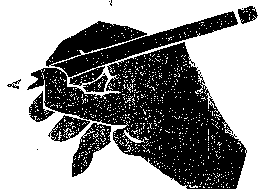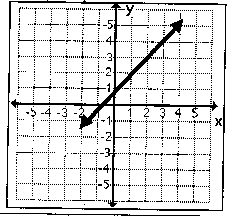Student Content Assessments
Instrument 2: The Basics for Process Writing
Project: Transactional Writing: Empowering
Women and Girls to Win at Mathematics
Miami-Dade Community College, Kendall
Funding Source: NSF: Program for Women and
Girls (HRD)
Purpose: To
develop skills that aid students
in both understanding and communicating their understanding
of mathematics
Administered To: Participating
students
Topics Covered:
- Content Specific Assessment: mathematics, writing
Format/Length: 4
open-ended questions that
are examples of the variety of questions that can be used
as prompts for Transactional Writing assignments. Also included
are the instructions, guidelines, and rubrics provided to
the teachers and the students. The rubrics were used by the
students when writing their assignments and also used by the
professors to grade the assignments.


Transactional Writing in the Math Classroom
This material is based upon work supported by the National Science
Foundation under Grant No. HRD - 9554188
GUIDELINES FOR WRITTEN ASSIGNMENT
(Price, 1989)
__________________________________________________________
| 1. PURPOSE: |
Develop skills in understanding and communicating in
mathematics; an exercise in learning and reporting what
you have learned; "if you can't explain it, you don't
understand it." |
| 2. AUDIENCE: |
Write to someone who needs help; start at the beginning
and be clear, logical and complete; make your paper "reader-friendly";
can someone learn from your paper? |
| 3. WARNING: |
Be careful not to make false assertions. Don't say something
"can be done." Do it! |
| 4. SUGGESTIONS: |
Try to write in complete sentences.
Keep sentences short; eliminate unnecessary words.
Use names of mathematical concepts, properties, etc.
Where appropriate, try to use mathematical symbols.
Where appropriate, refer to previously written assignments
by name and number.
When you finish, go back and read it again to make sure
you have given a clear answer.
Almost nobody can write anything well the first time.
Be prepared to rewrite.
Ask - Does it make sense? Can you follow it easily?
Read your paper aloud.
Have another student read your paper. |

THE BASICS FOR PROCESS WRITING
- Read the assignment question carefully. If there is more
than one part to the assignment, be sure to answer all of
them.
- Make a list of all the steps a person has to go through
in order to complete the process.
- Check your list to be sure the steps are in the correct
order; step 1 first, step 2 second, step 3 third, etc. Renumber
the steps if you have to.
- Think about the "person" you will use to write your answer.
Process writing is usually written in "second person." You
can show this in your writing in two ways. First, you may
use the words "you" and "your." Second, most of your sentences
will begin with verbs; the subject seems to be missing,
but it is really understood to be "you," which refers to
the person reading the assignment.
Notice that these instructions are written in second
person. The words "you" and "your" appear throughout the
steps listed here. Also, the first word in each section
is a verb ("read, make, check, think"). The subject of
each of these sentences is "you" even thought he word
is not written down! However, it is also possible to write
in first person, which would be indicated by "I" or "we."
If you are not writing in first or second person, then
you are writing in third person. Whichever person you
decide to use, be consistent throughout your writing.
- Decide on a format. For example, this sheet is written
using short paragraph entries. The beginning of each entry
is marked with a "bullet" [•] to catch the reader's
eye. Each entry is single spaced, and there is an extra
line between them. This blank line is called "white space,"
which makes the instructions easier to read. Also, each
line in the entry starts the same distance from the left
edge of the paper, making a neat column. In writing your
assignments, you could write short entries for each step,
just like on this sheet; then, to give your math examples,
you could leave some white space after the entry, center
your math example, and leave some more white space before
going to your next step. However you decide to format your
answer, you should use a consistent format throughout.
- Write your answer to the assignment question, following
the order in your list of steps using a consistent person
and format.
- To be best of your ability, use good grammar, punctuation
and spelling be especially careful to write in full sentences
since fragments have a way of making instructions difficult
for your reader to follow.

REVISION CODES FOR GRAMMAR AND PUNCTUATION
Condensed Version
| apos-c |
An apostrophe is needed for a contraction. ("let's"
means "let us," and "it's" means "it is") |
| apos-p |
An apostrophe is needed to show possession ("the house's
roof" means "the roof belongs to the house"). An exception
to this rule occurs with the word "it." The possessive
form of "it" doesn't have an apostrophe! (its roof) |
| apos-pl |
An apostrophe is not used for plurals. ("The houses'
are red" should be written "the houses are red.") |
| awk |
The underlined part of the sentences is written in an
awkward manner. This might also mean that the reader could
have trouble understanding its meaning. Find another way
to write this so it's easier to understanding. |
| cap |
The circled word should be capitalized. |
| com-conj |
Use a comma BEFORE a conjunction when it joins two sentences.
Conjunctions include: and, but, or, nor, so, yet, for
(when it means "because"). (She ran into the house, for
it started to rain.") |
| CS |
Comma splice: a type of run-on sentence. The sentence
really ends where you put the comma, but a comma is not
strong enough punctuation to end a sentence! Either use
strong punctuation to end the sentence (.;!?) or add a
conjunction after the comma; see com-conj.
("She ran into the house, it started to rain" is an example
of a CS). |
| com-series |
A comma is used to separate items in a series. (The
house has new doors, windows, and paint.) The comma in
front of the "and" is optional. |
| com-sub |
A comma is not needed between the subject and verb of
a sentence. ("She, ran into the house" is an example of
this common error.) |
| diction |
Word choice: either a word is used incorrectly, or the
word does not fit the meaning of the sentence. Perhaps
you do not clearly understand the meaning of the word. |
| end |
You have forgotten to put punctuation at the end of
the sentence. |
| frag |
This word group is a sentence fragment rather than a
complete sentence. There may be no subject for the verb,
there may be no verb at all, or the thought is not completely
expressed. Sometimes, the word group can be made part
of the preceding sentence or even part of the sentence
that follows it, whichever makes the thought complete.
("Because it started to ran" is an example of an incomplete
thought. What happened because it started to rain?) |
| FS |
Fused sentence: this is a type of run-on sentence. Unlike
CS, there is not punctuation at all between the two sentences.
Use strong punctuation to end the first sentence (.;!?).
("the house has a new roof it is made of special tiles"
should be "The house has a new roof. It is made of special
tiles.") |

SIX POINT SCORING RUBRIC FOR
TRANSACTIONAL WRITING: EMPOWERING WOMEN AND GIRLS
TO WIN AT MATHEMATICS
(Based on The Florida Writing Assessment Program rubric)
6 Points
- The writing is focused on the topic, has a logical organizational
pattern, and has ample supporting examples. The organizational
pattern is evident, including a command of transitional
devices. The paper demonstrates a sense of completeness
or wholeness. The writing demonstrates a mature command
of the language, including precise word choice. No grammar,
punctuation or spelling errors exist. The paper is written
in a consistent voice. The format of the paper is consistent
throughout and makes use of spacing to enhance readability.
5 Points
- The writing is focused on the topic, has a logical organizational
pattern, and has ample supporting examples. There is an
organizational pattern, including the use of transitional
devices, although a few lapses in either may occur. The
paper demonstrates a sense of completeness or wholeness.
The writing demonstrates a good command of the language,
including adequate word choice. There are minimal grammar,
punctuation, and spelling errors. The paper is written in
a consistent voice. The format of the paper is consistent
throughout and makes some use of spacing to enhance readability.
4 Points
- The writing is generally focused on the topic although
is may contain some extraneous or loosely related material.
An organizational pattern is evident and uses some transitional
devices, although lapses in either may occur. The paper
demonstrates a sense of completeness or wholeness. In some
areas of the response, supporting examples may be evident;
in other areas they may not be developed. Word choice is
generally adequate. There are some grammar, punctuation,
and spelling errors. The paper is written in a consistent
voice. The format of the paper is generally consistent
but makes little use of spacing to enhance readability.
3 Points
- The writing is generally focused on the topic although
it may contain some extraneous or loosely related material.
Although an organizational pattern has been attempted, lapses
occur and transitional devices may be sparsely used. The
paper may lack a sense of completeness or wholeness. Supporting
examples may not be developed. Word choice is adequate but
occasionally vague. There are some grammar, punctuation,
and spelling errors. While the voice of the paper is generally
consistent, lapses may occur. The format of the paper
is generally consistent but makes no use of spacing to enhance
readability.
2 Points
- The writing may be slightly related to the topic or may
offer little relevant information and few supporting examples
or both. There is little evidence of an organizational pattern,
including the lack of transitional devices. Development
of supporting examples may be inadequate. Word choice may
be limited or immature. Frequent errors may occur in basic
grammar, punctuation, and spelling. The voice of the paper
is not consistent. The format of the paper tends to be
inconsistent and makes no use of spacing to enhance readability.
1 Point
- The writing may only minimally address the topic because
there is little, if any development of supporting examples.
Unrelated information may be included. There is no evident
organizational pattern or use of transitional devices. Word
choice is limited or immature. Frequent errors occur in
basic grammar, punctuation, and spelling. The voice of the
paper is not consistent. The format of the paper is inconsistent
and makes no use of spacing to enhance readability.

MATH RUBRIC
| 0 Pt. |
Unable to read, unscorable |
| 1 Pt. |
The information provided does not relate to the prompt. |
| 2 Pts. |
The basic concept is unclear. The writing shows significant
confusion. |
| 3 Pts. |
The writing addresses the prompt but there are still
minor problems with clarity and mathematical vocabulary. |
| 4 Pts. |
The writing focuses on the prompt but there are still
minor problems with clarity and mathematical vocabulary. |
| 5 Pts. |
The writing clearly and adequately addresses the prompt
with good math vocabulary and precise directions. |
| 6 Pts. |
The writing accurately explains the prompt with clear
and effective word choice and with individual creativity
and style |

This material is based upon work supported by the National
Science Foundation under Grant No. HRD - 9554188
| no cap |
The word does not need to be capitalized. |
| POV |
Point of view: there is an unnecessary change in point
of view. Choose a point of view and use it consistently
throughout the writing. For process writing, second person
is usually used. "You" and "your" appear in the sentences.
("You must read directions carefully before you begin.")
Also sentences may start with verbs. ("Read directions
carefully before beginning.") Third person may be used
as well though it is less direct. ("Directions should
be read carefully before beginning.") |
| pp end |
The past participle ending of the verb is missing. ("She
was surprised" NOT "She was surprise.") |
| pro ref |
The reference for the pronoun that is circled or underlined
is unclear. Exactly what do you mean? |
| sp |
The word is spelled incorrectly. Use a dictionary or
other spelling aid to find the correct spelling. |
| sub vb ag |
The subject and verb in this sentences do not agree.
A singular subject needs a singular verb. ("The window
is leaking." Likewise, a plural subject needs a
plural verb. "Those windows are leaking.") |
MAC 1102
Writing Assignment #1
Student Name _________________________________
NSF (National Science Foundation) "Students Do The Write
Thing"
Professor Susan Buckley-Holland
DRAFT REVISION
(circle one of the above)
What is the difference between an equation and an inequality?
What type of problem would require an equation for its solution
and what type of problem would require an inequality? Give
examples.
| |
Student Writes In This Column
(continue on the back if necessary) |
|
| |
|
Professor Comments In This Column |
| |
|
|
| |
|
|
| |
|
|
| |
|
|
| |
|
|
| |
|
|
| |
|
|
| |
|
|
| |
|
|
| |
|
|
| |
|
|
| |
|
|
| |
|
|
| |
|
|
| |
|
|
| |
|
|
| |
|
|
| |
|
|
| |
|
|
| |
|
|
MGF 1113
Name ________________________________________
DRAFT W.A.#2
Instructor: Adelaida Ballester
Term: 98-1
WA#2:
There are many applications in the real world for the formulas
needed to compute areas and volumes of different geometric
figures. One major problem in selecting the correct formula
is in distinguishing area from volume. Discuss the differences
between surface area and volume of a rectangular solid having
one missing face. Give examples using such solids (specify
the units of measurement) illustrating your observations.
| |
Student's Work |
|
| |
|
Instructor's Comments |
| |
|
|
| |
|
|
| |
|
|
| |
|
|
| |
|
|
| |
|
|
| |
|
|
| |
|
|
| |
|
|
| |
|
|
| |
|
|
| |
|
|
| |
|
|
| |
|
|
| |
|
|
| |
|
|
| |
|
|
| |
|
|
| |
|
|
| |
|
|


Name_____________________________________________
DRAFT : or REVISION
Instructor _______________________________ Term
___________ Grade: Math/Language _____________________
Write a practical word problem related to your own life
experiences. Discuss how to solve your problem making use
of the principles for solving equations. (If applicable, include
a drawing, picture, graph, model, etc.)
| |
Student Writes here (use back if needed) |
|
| |
|
Professor Comments Here |
| |
|
|
| |
|
|
| |
|
|
| |
|
|
| |
|
|
| |
|
|
| |
|
|
| |
|
|
| |
|
|
| |
|
|
| |
|
|
| |
|
|
| |
|
|
| |
|
|
| |
|
|
| |
|
|
| |
|
|
| |
|
|
| |
|
|
| |
|
|


Name_____________________________________________
DRAFT : or REVISION
Instructor _______________________________ Term
___________ Grade: Math/Language _____________________
The Plane Coordinate System below had a linear equation
graphed. What is the linear equation that the line represents?
Explain how you discovered the equation and define each of
the mathematical terms that you use in your explanation.

| |
Student Writes here (use back if needed) |
|
| |
|
Professor Comments Here |
| |
|
|
| |
|
|
| |
|
|
| |
|
|
| |
|
|
| |
|
|
| |
|
|
| |
|
|
| |
|
|
| |
|
|
| |
|
|
| |
|
|
| |
|
|
| |
|
|
| |
|
|
| |
|
|
| |
|
|
| |
|
|
| |
|
|
| |
|
|
|
 |

